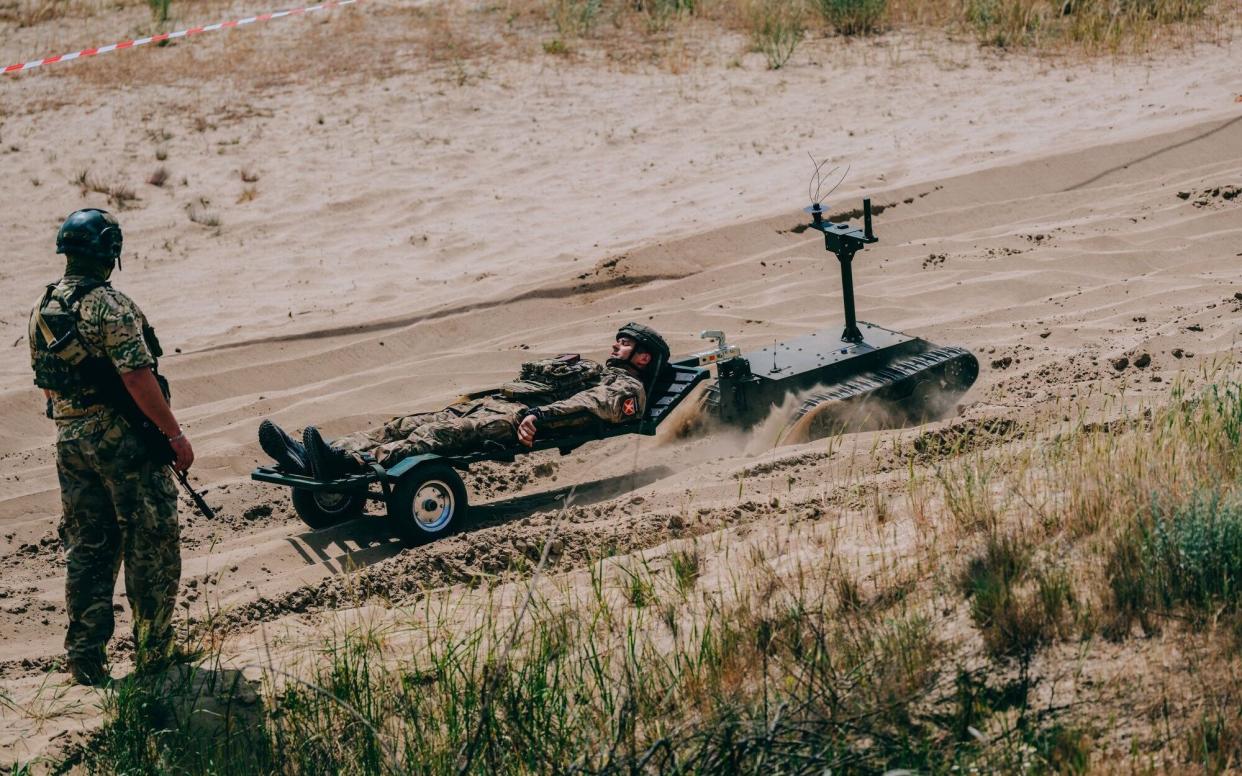Ukraine puts faith in robot army to hold back Russia

On the reconnaissance drone’s pixelated video feed, a small, four-wheeled robot trundles into view, coming to a halt on top of a Russian bunker before unleashing a powerful explosion.
The blast shrouds the area in a cloud of smoke, shredding the leaves from nearby trees as debris rains down on the surrounding trench system.
This is the moment the Ukrainian troops have been waiting for. But there is no mass infantry assault or tank charge.
Instead, a swarm of explosive-laden FPV drones – controlled by Ukrainian soldiers miles away – seeks to exploit the chink in the enemy’s armour, swooping down on the Russians and chasing them through zigzagging trenches that provide little protection against the airborne threat.
The devastating attack exemplifies a new type of warfare being pioneered by Ukraine, one that relies more heavily than ever before on unmanned and remotely operated robotic systems.
With Kyiv striving to overcome its dire manpower shortages, Volodymyr Zelensky, the Ukrainian president, is placing his hopes on an army of experimental robots to turn the tide against Vladimir Putin’s invasion.
The Telegraph was given rare access to information on the new types of robots that are already taking part in the combat in Ukraine.
For months, Ukrainian forces have been using the robots for everything from demolishing bridges, transporting supplies to the front line and evacuating wounded troops.
Ukraine’s unmanned ground vehicles (UGVs) are the latest development in the drone war that has grown to define the conflict in Ukraine.
The great hope is these technological developments will save the lives of Ukrainian servicemen, alleviating the burden of a severe manpower shortage, which experts have warned will get worse before it gets better.
“Unlike the enemy, Ukraine’s key is its people. Technology, particularly unmanned ground vehicles, allows for minimising human involvement on the battlefield, preserving the lives and health of Ukrainian soldiers,” said Nataliia Kushnerska, chief operations officer at Brave 1, the Ukrainian government’s defence innovations platform.
Brave 1 has been sifting through hundreds of ideas, blueprints and prototypes put forward by Ukrainian developers that believe they can help.
In March alone, more than 50 robots were sent to the front lines, without much in the way of official fanfare.
A month earlier, reports surfaced of Russian infantrymen attempting to capture a Ukrainian bunker outside the Donetsk region city of Avdiivka.
The invaders came under a hail of intense, accurate gunfire, which wasn’t deterred by a flurry of retaliatory mortar and small-arms fire.
When the machine-gunner position was eventually overran, the Russians discovered their opponent was no more than a hunk of metal.
It was likely one of four combat robots that are being rolled out slowly across the front line.
Some are fitted with PKT and PKM 7.62mm calibre machine guns, while others are designed for more heavy-duty operations with 12.7mm Browning machine guns that can hit targets just over a mile away.
The UGVs can be fitted with night-vision cameras and added armour protecting them from small-arms fire, matching the description of the gunnery robot that confronted advancing Russians outside Avdiivka.
Missions, including assaults, have been carried out with these laptops while their operators are sat in underground shelters some two-and-a-half miles away.
The Shablya M2 fixed, remote machine gunner is primarily used to replace the role of the long shifts put in by Ukrainian soldiers on defensive duties.
Engineers and developers have also taken inspiration from the Ukrainian armed forces’ use of one-way suicide drones in the skies and the waves.
Unmanned ground vehicles – dubbed Ratel-S and Ark-1 – can deliver 40kg of explosives under a tank or into a bunker at speeds of 15mph.
A reusable version can carry and deploy up to two TM-62 anti-tank mines on Russian positions or logistical routes.
Artificially intelligent aiming systems that don’t require human interaction are also being developed to counter Russian electronic warfare jammers that sever the connection between drones and their operators.
More universal logistics robots that can be repurposed for different tasks have also been tested.
The UGVs with ranges of 25 miles can carry loads of up to 600kg to deliver ammunition to front-line positions or evacuate a wounded soldier to safety.
Tracked versions are deployed in more torturous conditions, while a wheeled design delivers better performance when speed is of the essence.
“Our military is already using them on the front line. We have successful examples of using robots for demolishing bridges used by the enemy, delivering supplies to the front lines, evacuating wounded soldiers and inflicting damage on the adversary,” Ms Kushnerska said.
Drone warfare is seen as the only way Ukraine can overcome the numerical advantage Russia enjoys because of its willingness to absorb mass casualties.
The use of aerial, naval and ground drones have been increased in response to the slow deliveries of more conventional Western weapons systems from Kyiv’s backers abroad.
British intelligence officials estimated 500,000 Russians had been killed or wounded in the war, in a social media post published on Friday.
Both Ukraine and Nato share an opposition to this level of human waste, something officials in Kyiv believe will eventually see Western militaries adopt its technological creations.
At least 21 of the robots being trialled on the front lines are “codified according to Nato standards”, said Ms Kushnerska.
“We are confident that unmanned ground vehicles will become the next game-changer in this war, just as drones have already become. This is our asymmetric response to the enemy’s numerical advantage,” she added.



